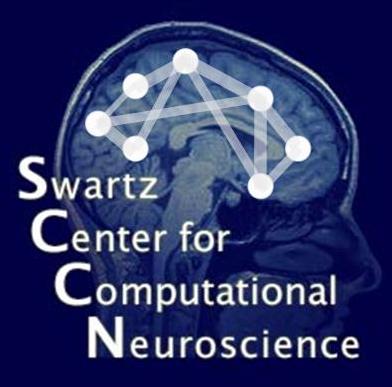EEGLAB Home
Workshop Program
This Talk -- Scott Makeig, Director of the Swartz Center for Computational Neuroscience (SCCN), UCSD, and founder / co-developer of the EEGLAB project, begins the Workshop with a (November 2010) overview of EEG research, its motivation, biology, analysis, and potential future applications, and an overview of the original EEG data processing approach that EEGLAB enables.
You may download the (.pdf) slides used in the talk here. Press FS on the lower right corner of the video image to view the talk in full screen display.
Chapter 1
(8:08) gives a brief history of the development of the EEGLAB environment project, including its origin in the ICA Electrophysiological Data Analysis Toolbox first put online by Makeig and colleagues at Salk Institute in the laboratory of Terry Sejnowski at Salk Institute in 1997.
Download the slides for this chapter.
|
|
Terms introduced (with links):
|
|
Study the slides for this chapter here. |
For further reading:
|
Chapter 2
(6:59) places EEG analysis in its most basic context, the age old question and "heart of the matter" -- 'Who Am I?.' It discusses the growing importance to cognitive neuroscience of observing and modeling patterns of distributed brain dynamics supporting our experience and behavior, a quest in which non-invasive high-density EEG imaging appears destined to play an important role.
Download the slides for this chapter.
|
|
|
|
Study the slides for this chapter here. |
|
Chapter 3 (15:02) discusses the central biological question on which any cogent EEG research program must be built, 'What is EEG?'. The history of functional brain imaging (beginning with the development of EEG recording about 1926) is reviewed. The difficult problem that brain dynamics are deeply multiscale is emphasized. Download the slides for this chapter.
|
|
Questions:
|
|
Study the slides for this chapter here. |
|
Chapter 4 (7:56) discusses the marked difference between scalp EEG data channel signals themselves and the underlying cortical EEG source processes. The very broad 'point-spread' function characterizing the spread of potential from cortex to scalp is a basic obstacle to using EEG to perform 3-D functional brain imaging -- one that spatial source filtering methods developed in the last 20 years can powerfully alleviate. Download the slides for this chapter (pdf).
|
|
Questions: |
|
Study the slides for this chapter here. |
|

